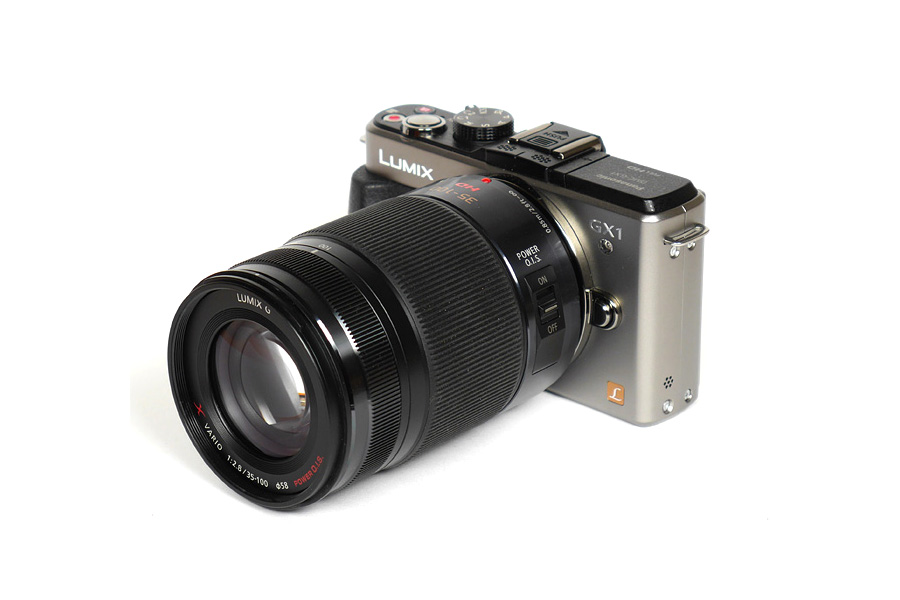
Micro-Four-Thirds (MFT) may offer the most extensive mirrorless lens system but even so it has one significant shortcoming – professional-grade MFT tele-zoom lenses are rare. Very rare. Essentially, ambitious users have the choice between … well … one lens – the Panasonic Lumix G X 35-100mm f/2.8 Power OIS (Note: Olympus is going to release a 40-150mm f/2.8 in 2014). Now while this simplifies your purchasing options quite a bit, it is still interesting to have a deeper look, of course. 🙂
In full format terms, it offers a “70-200mm” range with a f/2.8 speed but depth-of-field capabilities equivalent to “f/5.6”. A pricing of more than a grand (US$/EUR) may feel a bit steep when thinking about it.
Typical for the MFT lenses, the Panasonic lens is surprisingly compact with a constant length of merely 10cm and a weight of just 360g. The build quality is excellent thanks to a tightly assembled combination of high quality plastic and, primarily, metal parts. The broad zoom and focus control rings operate exceptionally even and smoothly – the rubberized zoom ring collects dust like hell though as you can also see in the product image below. That being said, the lens is sealed against dust and also splash-proof.

The AF of the lens is based on a fast and virtually silent linear stepper motor. Typical for a system relying on contrast-detection AF, there were no issues with AF accuracy during our field tests. Manual focusing is still “by-wire” – thus you operate the AF by turning the focus ring – but the implementation is so good in terms of focus feedback that it doesn’t make any difference anymore. A focus-distance scale is missing but then you usually got one on your display/viewfinder anyway. The Panasonic lens features a “Power OIS” (Optical Image Stabilizer) which can give you an extra potential of about 3 f-stops.
| Specifications | |
|---|---|
| Equiv. focal length | “70-200mm” (full format equivalent) |
| Equiv. aperture | “f/5.6” (full format equivalent in terms of depth-of-field) |
| Optical construction | 18 elements in 13 groups inc. 1xUED & 2xED elements |
| Number of aperture blades | 7 (circular) |
| min. focus distance | 0.85m (max. magnification: 1:10) |
| Dimensions (L x W) | 67x100mm |
| Weight | 360g |
| Filter size | 58mm (non-rotating) |
| Hood | barrel-shaped, bayonet mount, supplied |
| Other features | Nano-Coating, Power OIS, weather sealing |
Distortion
Traditionally this is a bit of a weak point of MFT lenses because the system relies on software auto-correction here. You may argue, of course, that this is not relevant from a user perspective because all the applied corrections are applied “under the hood”. This is also something that we can confirm – standard JPEGs or conventionally converted RAW files don’t show a significant amount of distortion throughout the zoom range.
That being said it is still interesting to look a bit behind the scenes by using an “unsupported” RAW converter. This reveals a native barrel distortion level of about ~3.5% at 35mm which is rather heavy albeit not extreme. Therefore an auto-correction isn’t overly “lossy”. The issue has eased at 70mm (1.5%) and is basically negligible at 100mm.
Corrected:



RAW:
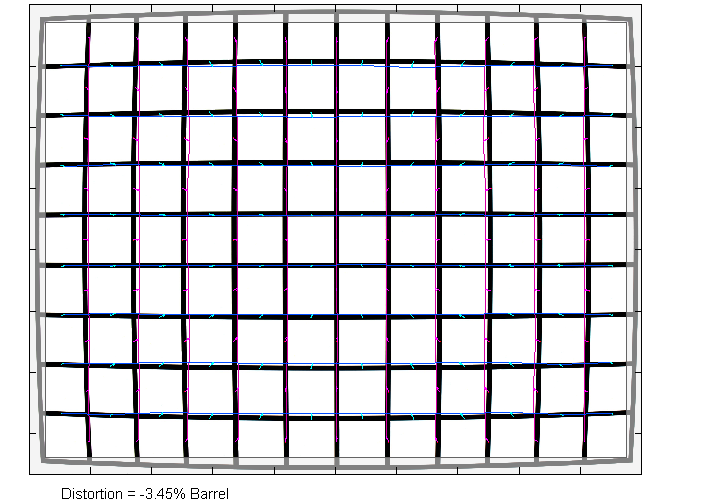
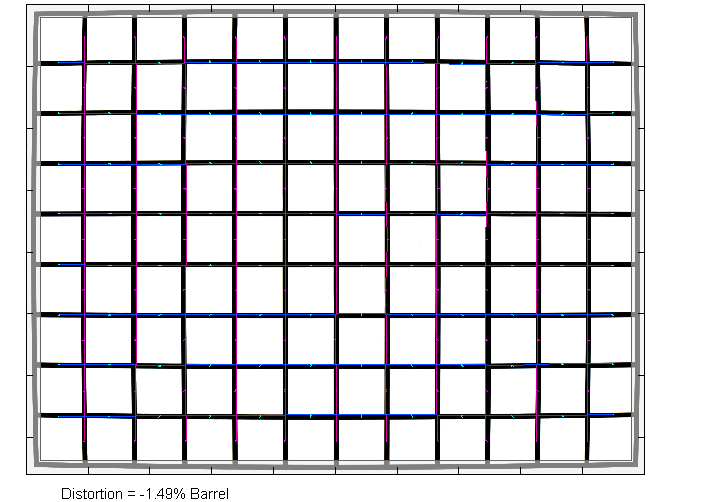
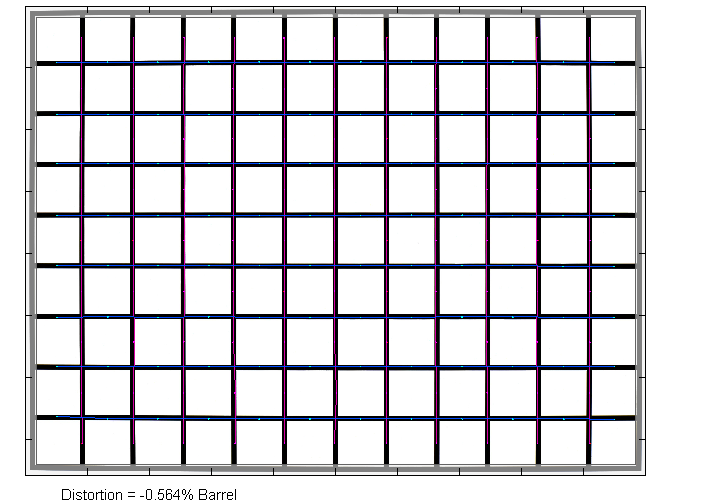
Vignetting
At 35mm, the distortion auto-correction reduces the vignetting from its original characteristic (due to image stretching). In consequence there is, again, not much to worry about here. The light falloff remains visible at f/2.8 but it’s not overly disturbing. When closing the aperture by one stop, the issue is essentially irrelevant already.

The “raw” vignetting is somewhat more pronounced at ~1.3EV (f-stops) @ 35mm f/2.8 and ~1.2EV @ 100mm f/2.8. Stopping down to f/4 is therefore advisable in critical scenes if you prefer to process your RAWs without applied distortion correction (if you can).

MTF (resolution)
Regarding the professional-grade scope, we had high expectations during the MTF analysis and the lens was able to fulfill these hopes – at least mostly. The primary strength of the Panasonic lens is a superb center resolution straight from f/2.8 and throughout the zoom range. There’s just a minor drop at 100mm @ f/2.8 which is already recovered at f/4. The borders are generally very good followed by good to very good corners. As usual, diffraction is a limiting factor when stopping down thus unless needed you should stay below f/11, better below f/8 to get the most from your lens.
The field curvature is generally low. The centering quality of the tested sample was good (albeit you may spot an irregularity in the first of the provided sample images – this didn’t show up during the tripod-based lab tests though).
Note: You may be surprised about the “odd” MTF curves below where the center performance starts to decrease straight after f/2.8 or f/4. This relates to the diffraction characteristic of the system. The empirical optimum is around f/2.8 on MFT, f/4 on APS-C and f/5.6 on full format cameras – unless the design itself is the limiting factor.
Please note that the MTF results are not directly comparable across the different systems!
Below is a simplified summary of the formal findings. The chart shows line widths per picture height (LW/PH) which can be taken as a measure for sharpness. If you want to know more about the MTF50 figures you may check out the corresponding Imatest Explanations
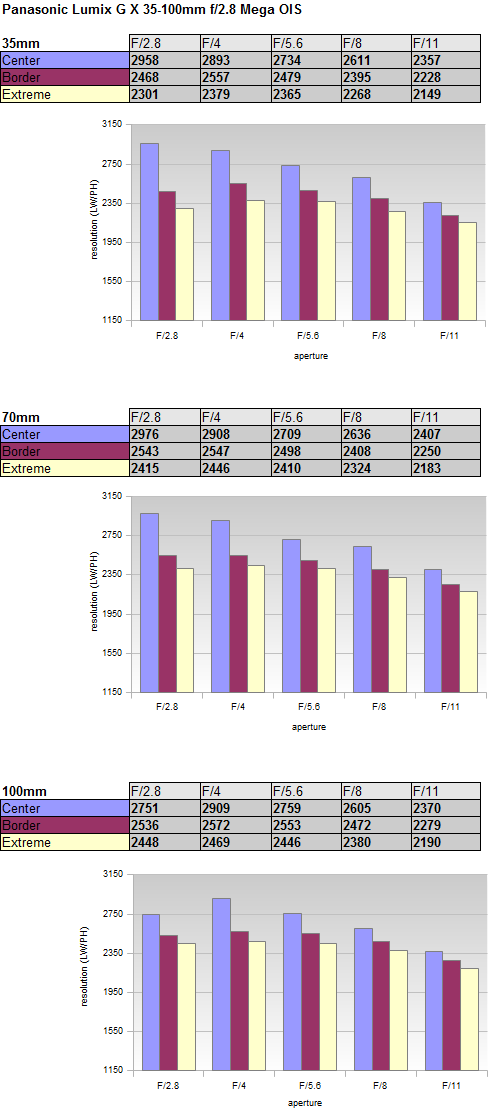
Chromatic Aberrations (CAs)
Lateral CAs (color shadows at the image borders) are low with an average pixel width of ~1px at f/2.8 and ~0.7px at medium aperture settings. It is somewhat unclear whether the CAs are auto-corrected – the RAW CAs are just a tiny bit higher. Thus Olympus users dont’t need to worry as well – as of the time of this review, CA auto-correction is only available on Panasonic cameras and the new Olympus OM-D E-1.

Bokeh
One of the primary usage scenarios for a large aperture lens is to separate the main subject from its surroundings. In such an image the quality of the bokeh (out-of-focus blur) is of major significance.
The Panasonic Lumix G X 35-100mm f/2.8 Power OIS delivers pleasing results here. The rendition in the focus transition zone is very smooth and buttery in the critical background whereas the foreground blur is slightly nervous.

Out-of-focus highlights have a circular shape but the discs show a slightly “onion-like” substructure – an effect that gets somewhat emphasized when stopping down. As usual the circular shape also deteriorates towards the image borders (see also one of the provided sample images).

Bokeh Fringing / Longitudinal Chromatic Aberrations (LoCA)
Bokeh fringing is a common characteristic with fast glass. It’s visible as halos of different colors in out-of-focus areas – magenta (red + blue) in front of the focus point and green beyond.
The Panasonic lens exhibits only a marginal amount of fringing at max. aperture – thus it is almost a super-apochromatic lens! This is very rare. The remaining traces are essentially gone at f/4.

Sample Images
The Panasonic Lumix G X 35-100mm f/2.8 Power OIS is an expensive tele zoom lens but it lives up to its high reputation. From a user perspective, there is little to complain. It is dead sharp in the image center and pretty good in the border region. Since distortions are auto-corrected, there is nothing to worry about here. You may spot some light falloff in the corners at f/2.8 but it's not overly disturbing and gone from f/4 onward. Lateral CAs are quite low. The quality of the bokeh - a major aspect of a fast lens - is very good. The background blur is beautifully rendered and there's almost no bokeh fringing. On the downside the less critical foreground bokeh is slightly busy and highlight discs aren't totally perfect. When looking behind the scenes - thus into uncorrected RAW files - you can spot a fairly high albeit not excessive degree of distortion at 35mm. Other than that there're no issues in the original characteristic of the lens.
The build quality of the lens is excellent thanks to high quality materials, weather sealing and a constant physical length throughout the zoom range. The focusing speed is high and essentially noiseless so the AF may also be usable for movies to a certain degree. Panasonic's "Power OIS" (image stabilizer) is well proven by now. It may not excel like the Canon or Nikon counterparts but it can give you some extra potential when shooting without a tripod in low light situations.
All-in-all a very capable lens and as such "Highly Recommended"!
-
Optical Quality
-
Build Quality
-
Price / Performance

